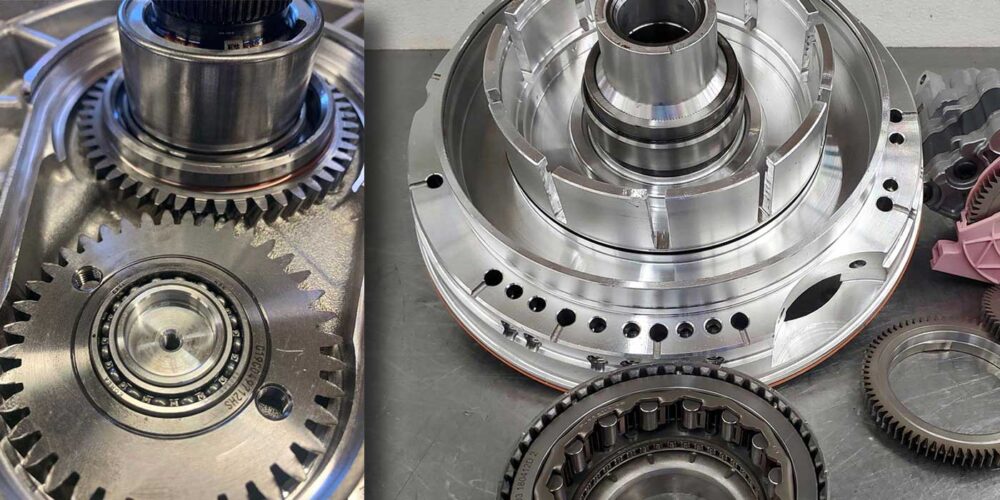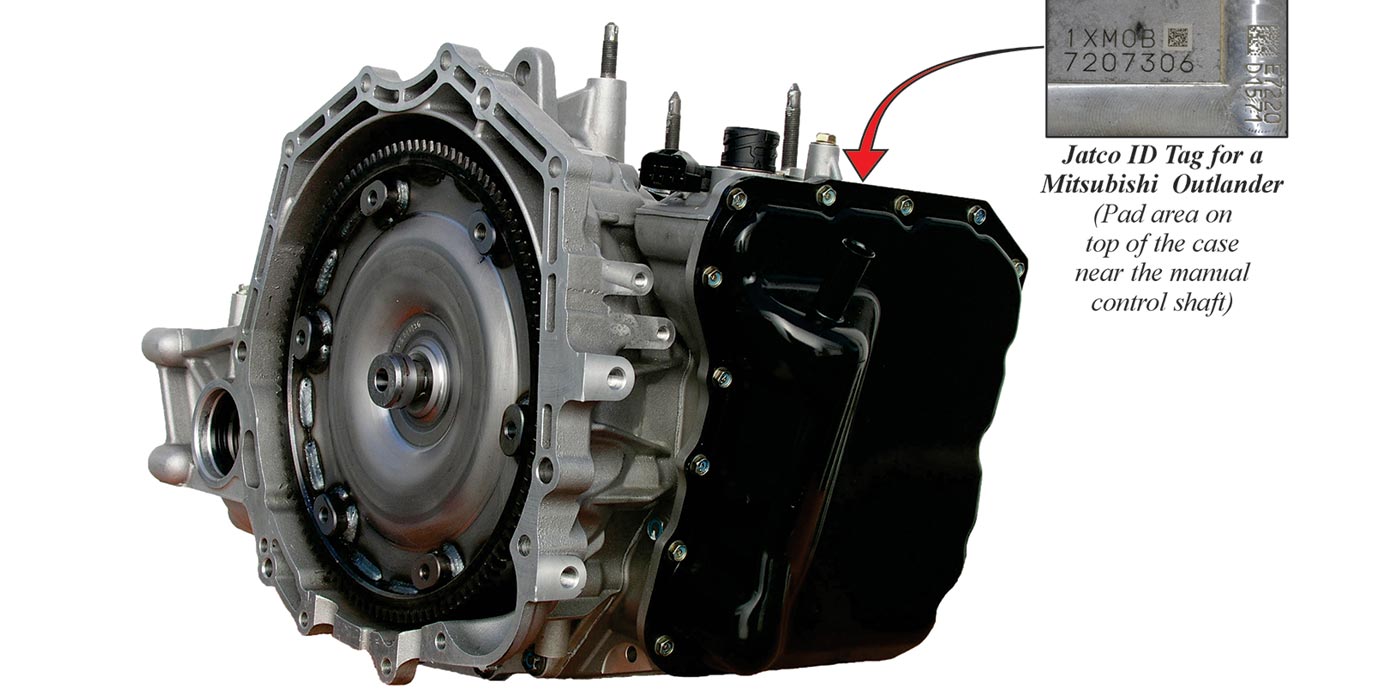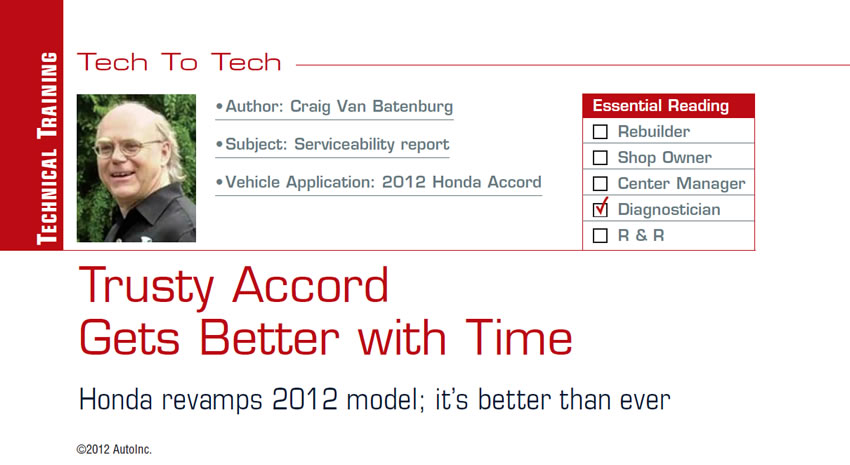
Tech to Tech
- Subject: Serviceability report
- Vehicle Application: 2012 Honda Accord
- Essential Reading: Diagnostician
- Author: Craig Van Batenburg
Honda revamps 2012 model; it’s better than ever
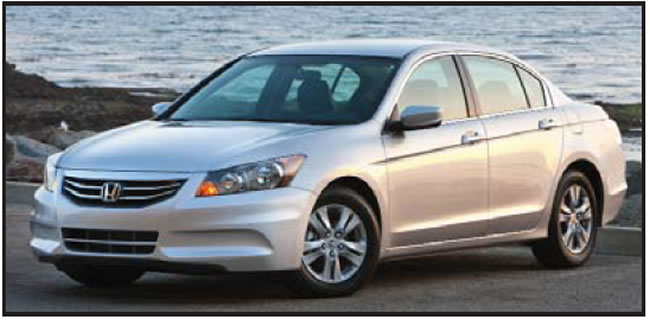
This time, let’s focus on the Honda Accord and compare the current 2012 LX with the 1997 model.
In 2008, Honda redesigned the Accord, and the 2012 model may be the final year of that generation.
In 1968, I got a part-time job fixing Honda motorcycles after high school. I fell in love with Hondas and have had a 40-plus-year career working on its products.
Honda was a motorcycle company until the mid-’60s, when it started making small cars and trucks, but they were not imported into America until the early ’70s. They went nationwide in 1972 with the model-year (MY) 1973 Honda Civic 1200. The Accord came later – in 1975 – as MY 1976.
In 1978, Honda added the LX version that had many standard features you had to pay extra for on the competition. A year later you could buy a four-door sedan, but before then they were all two-door hatch models. Each year saw small improvements, and each model changeover made big news.
Somewhere in the late ’90s, it looked like Honda lost its way. No big technology advancements, and styling was either boring or strange. I bought a new 2000 Insight (the first hybrid sold in America), but Toyota countered with its Prius and we know how that has gone so far. But never count Honda out, even when it is down.
Where is the Accord these days when it comes to the technical servicing aspect?
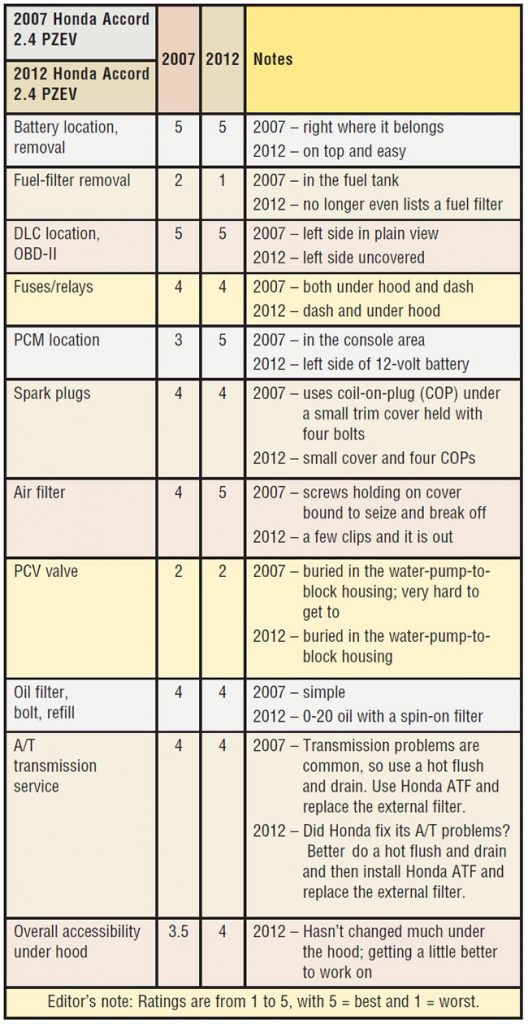

2012 LX 2.4 PZEV with A/T
The V-6 is still available but it is just a matter of time before that is gone, as the four-cylinder is the most popular and corporate average fuel economy (CAFE) standards will kick in soon, raising the bar. All four-cylinder models today are available in partial-zero-emissions-vehicle (PZEV) configurations.
PZEV engines include two modes of exhaust-valve operation. Below 2,500 rpm, only one exhaust valve operates, creating a strong rotational flow in the exhaust gases that creates a “thermal reactor” effect to reduce hydrocarbon emissions. Above 2,500 rpm, where exhaust flow increases, a hydraulically actuated pin locks the rockers for both exhaust valves together so they operate in unison, following a single cam profile. A version of this trick is also used in the Insight gas/electric hybrid and many other Honda cars.
What is VTEC?
Variable valve timing and lift electronic control (VTEC) is an electronic and mechanical system in most Honda engines that allows the engine to effectively have multiple camshafts. As the engine moves into different rpm ranges, its computer can activate alternate lobes on the camshaft and change the cam’s timing. In this way, the engine gets the best features of low-speed and high-speed camshafts in the same engine.
Go to a search engine and look for a video for VTEC. It is quite simple once you see it in operation.
The ‘Green States’
Honda sells the PZEV version of the car in only California, Florida, Vermont, Connecticut, Arizona, Maryland, Massachusetts, Pennsylvania, New York, Oregon, Maine, New Jersey, Rhode Island, New Mexico and Washington state. Some of these locations are known as the “Green States.”
Courts get involved
In September 2009, a class-action suit was filed alleging that the braking systems on 2008, 2009 and certain 2010 Honda Accord vehicles as well as 2009 and certain 2010 Acura TSX vehicles suffer from a defect that causes excessive force to be applied. The owners noticed that the vehicle’s rear brake pads would wear out and require replacement about every 15,000 to 20,000 miles.
The Internet now allows such findings to get reported rapidly as owner chat groups are created. On April 6, 2010, a preliminary settlement to the class action was announced by which Honda would reimburse owners for a portion of their prior brake-repair expenses, and Honda would also pay up to $150 for owners to have redesigned brake pads installed. Final court approval of the settlement was granted July 29, 2010. Hidden defects are becoming a thing of the past.

2007 Honda Accord LX 2.4 PZEV with A/T
Honda uses its trusted DOHC 2.4-liter four-cylinder as the power plant. The variable timing and lift are on the intake side only. Honda calls it “i-VTEC.” It makes 166 hp and 160 lb.-ft. of torque.
Those numbers allow the automatic to select the proper gear ratio and use the motor’s full potential. That allows for an impressive 0- to 60-mph time in the low-8-second range. That is average in its class, which included Chrysler Sebring, Toyota Camry, Nissan Altima, and the Saturn Aura way back then.
Honda’s motor is best in class. It has (for a four-cylinder) excellent throttle response and broad torque band – making it one you can live with every day. The Accord gets 24 mpg in the city and 34 on the highway. If you bought the manual, expect 26 in the city.
My 2007 was a great car, but not perfect. Expect to see problems with the evaporative-emission-control (EVAP) system, some exhaust-gas-recirculation (EGR) issues and owners who don’t change the oil often enough to keep the VTEC system operating well, so they get VTEC codes. Honda uses a chain to spin the camshaft. The chain is maintenance free and will last a lifetime if the oil and filter are replaced when needed. In 2007 it was still power steering using that old-fashioned fluid. It never hurts to flush it out. Make sure you use the proper fluid, because Honda is fussy about that part of its car. The spark plugs are part number IZFR6K-11, and for best performance use the original brand, NGK.
Honda has suffered for years with automatic-transmission complaints. How many are real there is no way to know, but it sure has hurt Honda’s reputation.
2007 Accord summary
With a good scan-tool time, some marketing to Honda and Acura owners, using quality parts and good understanding of the “Honda Way,” this very popular car can help pay the bills. You must get the preventive-maintenance business, because breakdowns do happen but not often enough.
2012 Accord summary
The latest offering is better in small ways. There are clips on the air-filter cover instead of screws. The PCM is under the hood, not in the console, so it now has better access. No fuel filter is even listed, so I guess Honda believes that is never a problem. We will see. 0-20 oil is the preferred weight, and most everything is within reach.

Craig Van Batenburg, AAM, is a master hybrid technician. He was the owner and lead technician for more than 25 years at his own shop that specialized in Honda and Toyota vehicles. Van Batenburg was the president of ASA Massachusetts from 1993 to 1996. He is owner of the Automotive Career Development Center (ACDC), which he founded in 1998. He develops technical classes for those who require updating their knowledge in hybrid and electric cars. Some of his customers include the U.S. Army, U.S. Marine Corps, Delphi, Midtronics, John Deere, Porsche of America and BG Products. You can reach Van Batenburg at [email protected].
This copyrighted article is reprinted with the permission of AutoInc., the official publication of the Automotive Service Association (ASA). To learn more about ASA and its commitment to independent automotive-service and repair professionals, visit www.ASAshop.org or call 800-272-7467.





